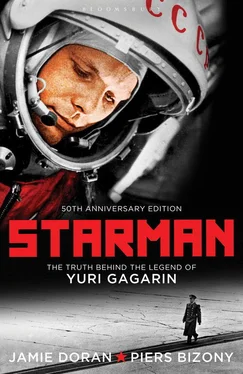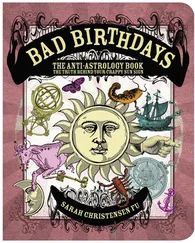Actually Sergei was the famous aircraft designer, and his son’s name was Vladimir; nor does Bobrovsky sound entirely like a citizen of France. It made no difference to all these rumours that Korolev’s launch technicians had daubed maket (meaning ‘dummy’) in thick black paint all over Ivan’s face and across the back of his suit, before strapping him into Vostok’s ball and sending him off; nor that his soup recipes, beamed back from space, were so obviously the product of a tape-recorder, rather than a live human being. Ivan’s choice of subject matter was the cause of heated debate before his flight, as Oleg Ivanovsky recalls. ‘We needed to check the radio’s ability to convey human speech from space, so we decided to put a tape together. Then the security officials said, “No, because if the Western listeners hear a human voice, they’ll think we are secretly flying a real cosmonaut on a spying mission.” Remember, this was only a few months [eleven months] after the Gary Powers business. So we thought we’d record a song instead, but the security people said, “What, have you gone mad? The West will think the cosmonaut has lost his mind, and instead of carrying out his mission he’s singing songs!” Then it was decided to record a choir, because nobody would ever think we’d launched an entire choir into space, and in the end that’s what we did, along with the recipes.’
A less realistic dummy had preceded Ivan on March 9. With these two tests successfully completed, Korolev decided that Vostok was finally ready for a real pilot. He had no choice but to take some risks. NASA’s Mercury programme was about to send an American into space. They, too, were prepared to fly brave military volunteers atop missiles with a less-than-perfect launch history, just so long as they could beat the Soviets.
Incidentally, Mazzhorin and his guidance experts had access to many of the documents openly published by NASA, but they also received secret Intelligence reports about forthcoming launch preparations at Cape Canaveral, including the engineering delays and unmanned test failures that dogged the early phases of the Mercury project. This helps to explain why so many Soviet space successes pipped their US equivalents to the post by just weeks, or even days on some occasions. ‘I remember once I got this three-page document, data about various secret orbits that the American satellites were following, and I said, “What do I need this for? This is just Newton’s Laws of Gravitation.” But I reckon our spies had to get those numbers from somewhere. Of course the Americans knew what we were doing, but they stayed silent because we stayed silent. Each side was pretending not to know the other’s business. It wasn’t a very adult game to play, but it led to great technical progress on both sides and a global space industry with benefits for everybody.’
Quite apart from these complex games of international strategy, the simplest and cheapest security measure that Mazzhorin ever had to organize was for the cosmonauts’ benefit alone. ‘We put a pistol into Vostok’s survival kit, just in case our man landed in the African jungle or some such place, and had to protect himself against wild animals. Not against people, of course. He was supposed to ask any people he came across to help him. He wasn’t supposed to shoot them.’
By the end of 1960 six men from the cosmonaut squad of twenty had been selected as potential candidates for the first Vostok flight. The list was based on the cosmonauts’ abilities and their training record over the previous year; however, there was a more arbitrary factor at work – height, or rather, the lack of it. Vostok’s ejector seat could only accommodate a crewman of modest stature. Gagarin’s short frame made him ideal, as did Gherman Titov’s. Alexei Leonov was a highly proficient candidate, but he was too tall for Vostok in its current configuration.
On March 7, 1961 Valentina Gagarina delivered a second child, Galya. Three weeks after this happy event, Gagarin had to leave for Baikonur, where he and Titov were scheduled to rehearse their final pre-flight checks. By now, they were the only serious candidates in the running for the first flight, the list of six having been whittled down yet further. Both men were aware that a final selection for the first flight would not be made until the very eve of launch, scheduled for April 12. Competition was fierce, albeit understated. ‘Of course I wanted to be chosen,’ Titov explains today. ‘I wanted to be the first into space. Why shouldn’t I? Not just for the sake of being first – simply because we were all interested to see what was out there.’
Titov and Gagarin tried to outdo each other in their cooperation towards each other, knowing that a spirit of professionalism and teamwork would mark them out as suitable choices. A third potential candidate, Grigory Grigoryevich Nelyubov, miscalculated badly, deliberately trying to push himself forward as the only suitable man for the historic first flight. By the end of March, he was no longer in the running.
On arriving at Baikonur, the cosmonauts’ first task was to learn how to dress in their spacesuits. The decision to make the suits had only been taken in mid-1960, after a series of difficult discussions. Many designers thought that Vostok’s pressure-shell should be enough to protect its pilot, and Korolev was worried about the extra weight penalty imposed by the suit and its separate life-support system. However, he was swayed by the safety arguments. He turned to Gai Severin, Russia’s most experienced maker of pilot garments and ejection systems, and said bluntly, ‘You can have the weight allocation [in Vostok] but we need the suits in nine months’ time.’ [1] Interview with Gai Severin, quoted in Harford, Korolev , p. 162.
Severin based his suits on the high-pressure aircraft garments he had designed in the wake of the Korean War. The pro-communist pilots in Soviet-built MiGs often lost consciousness if they turned their planes too suddenly during combat, while their American enemies managed to stay awake. Severin realized that a tight pressure-suit could help against the g-forces. After he had dressed the pilots more suitably, the Americans became less keen on chasing MiGs round sharp corners. Using a similar design, his spacesuits would help to brace a cosmonaut against the acceleration of the R-7 rocket. The tight fit, especially round his legs, would prevent blood from pooling in his lower torso and starving the supply to his brain. The strong, airtight layers of the space outfit were made from a tough, blue-tinted rubberized compound, while the outer orange material – familiar to Western observers from publicity photographs – was not particularly important for survival. It was just a coverall to smooth out the various bumps and seals, made from a brightly coloured fabric so that a cosmonaut could easily be located if he came down in a snow-covered region. The Soviet Union in April had many snow-covered regions.
Severin was on hand now to teach the cosmonauts how his spacesuit worked, while the Chief of Cosmonaut Training, Nikolai Kamanin, watched carefully. This lesson was also for the benefit of the attending technicians, who had to be able to handle every component with flawless efficiency, so that nothing would be forgotten on launch day. Two spare outfits were allocated so that the ‘real’ suits would remain unblemished until they were needed. Then, fully suited up, the cosmonauts took turns clambering through the hatchway of a duplicate Vostok ball, while the pad crews practised strapping them down. Kamanin supervised mind-numbingly repetitive run-throughs of the emergency ejection routine: setting all the right control switches in the cabin, ensuring the suit and helmet were sealed, and above all preparing the body, tensing the muscles, for the violent shock to come. In a real emergency Gagarin and Titov would have to be able to do all these things without a moment’s thought.
Читать дальше












